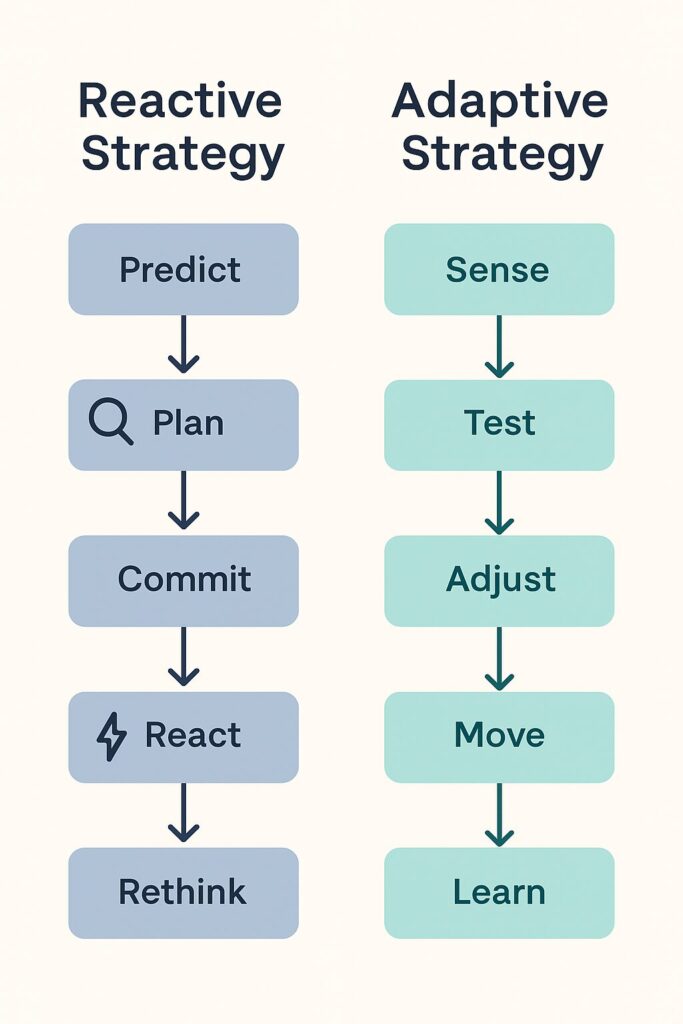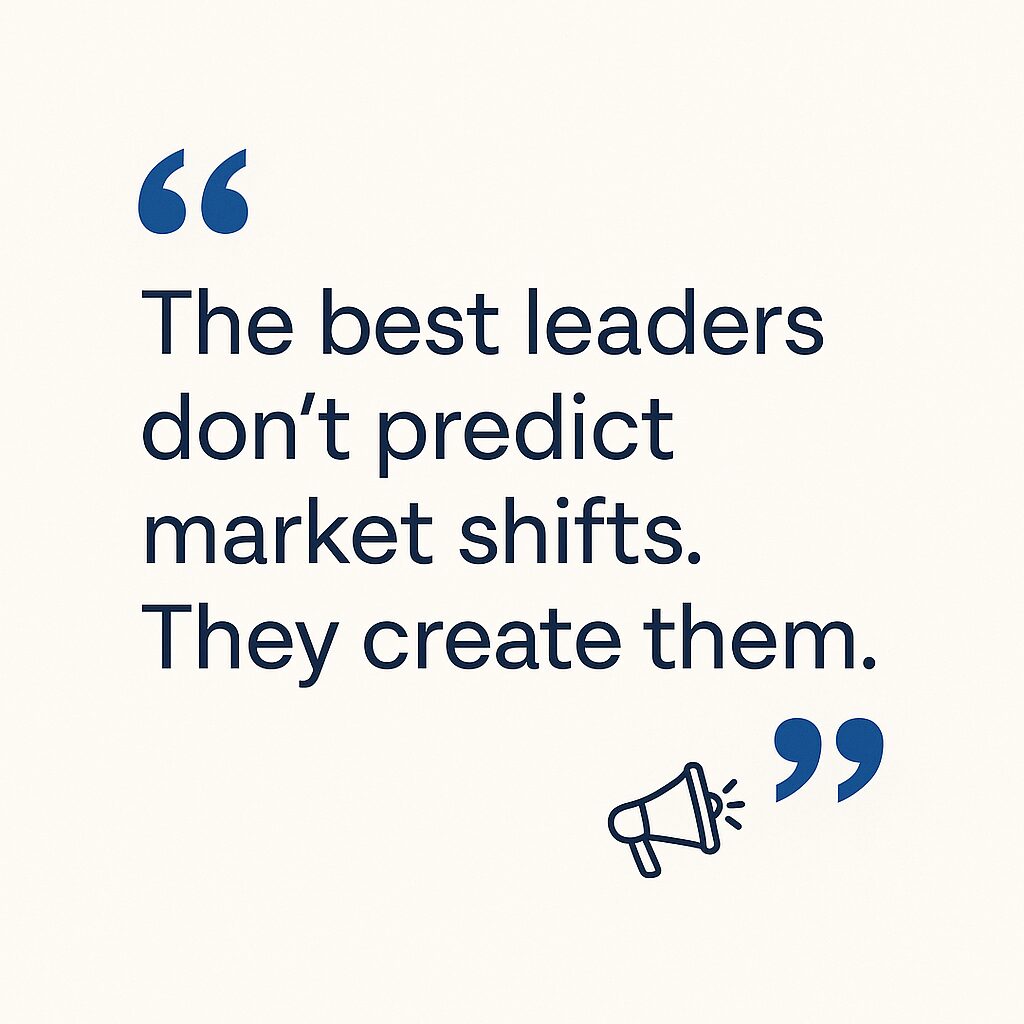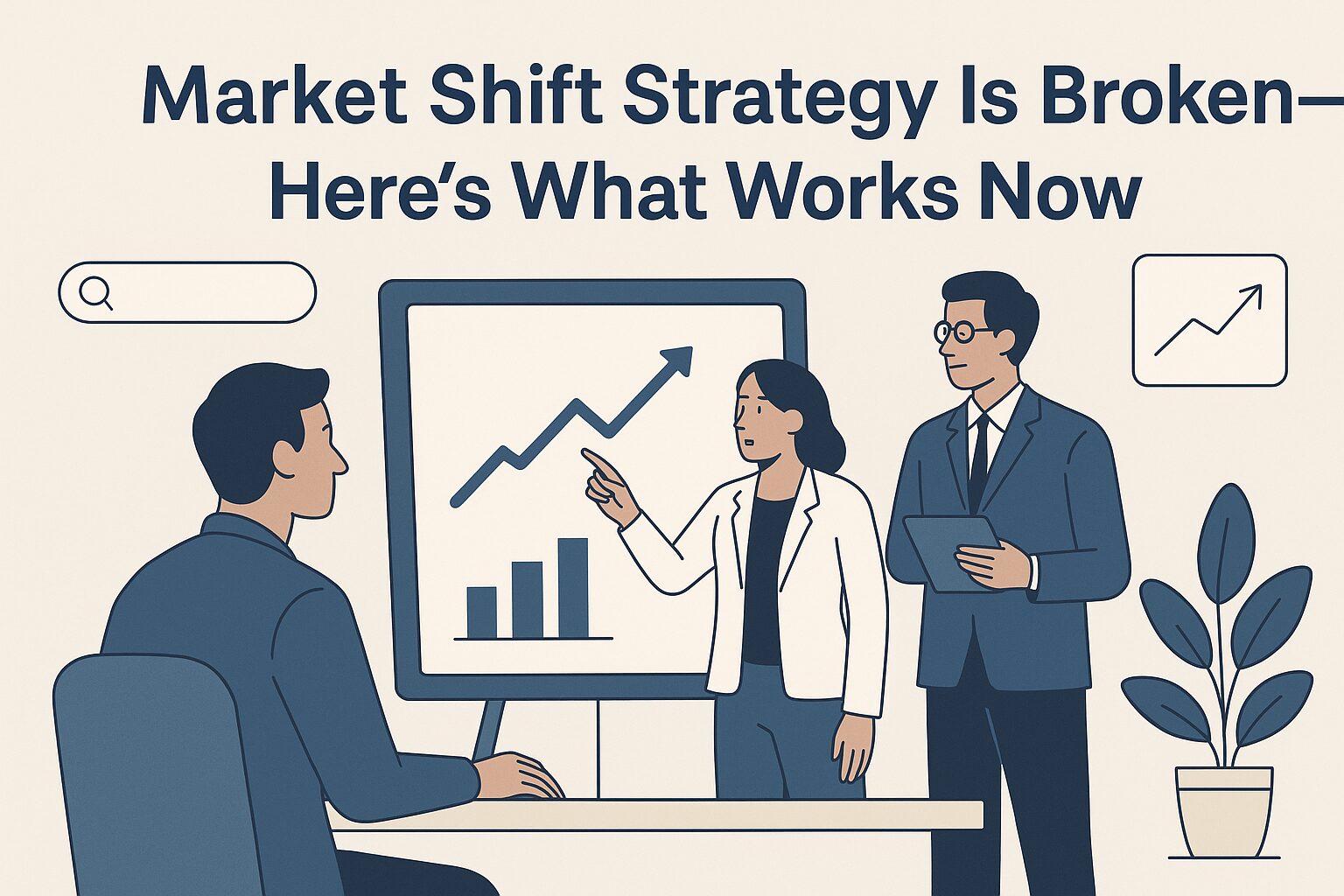Let me start with a confession that might piss off every strategy consultant on LinkedIn: 95% of market shift strategy is complete garbage.
There, I said it.
We’ve created this entire industry around “predicting the future” and “strategic foresight,” that’s about as useful as a chocolate teapot. CEOs spend millions on consultants with fancy slide decks full of trend analyses and market predictions. They develop elaborate scenario planning processes and hire futurists to predict what’s coming next.
And then they get blindsided anyway.
Blockbuster had armies of analysts. Kodak invented the digital camera. Nokia dominated mobile phones. BlackBerry owns business communication. These weren’t companies lacking in business trend forecasting capabilities – they were drowning in them.
The dirty secret? The problem isn’t that we’re bad at predicting the future. The problem is that we’re trying to predict the future in the first place.
“COVID‑19 drove a decade’s worth of digital adoption in less than a year.” — McKinsey & Company
The Fortune Telling Fallacy That’s Killing Your Strategy
Here’s what happened to me in 2019 that changed how I think about market shifts forever.
I was at Realtor.com, and we spent months building what we thought was bulletproof market intelligence. We analyzed homebuying patterns, mapped demographic shifts, studied technology adoption in the real estate industry, and created detailed scenarios for how the industry is expected to evolve over the next five years.
Our prediction? The shift to digital-first homebuying would be gradual. Although millennials were more tech-savvy, real estate was still fundamentally a relationship-driven business. Virtual tours might grow, but people would still want to walk through homes physically. The industry would slowly modernize, but the core experience would remain essentially unchanged.
Then COVID hit.
In three months, we saw changes we predicted would take three years. Virtual tours went from a “nice-to-have” to an absolute essential overnight.
Buyers and sellers who once needed in-person meetings now complete entire transactions over video calls. Many buyers, who previously wouldn’t dream of purchasing a home without seeing it in person, began making offers based solely on virtual walkthroughs. The industry didn’t gradually evolve. The company transformed in weeks, not years, under pressure.
Our beautiful, data-driven predictions weren’t just wrong – they were spectacularly, embarrassingly bad.
But here’s the comforting truth: so was everyone else’s.
“Over 75% of people using digital channels for the first time during COVID say they’ll continue post‑pandemic.” — McKinsey
McKinsey got it wrong. BCG got it wrong. Every major consulting firm and research company completely missed the speed and scale of the retail transformation. Not because they lacked data or analytical capability, but because they were playing the wrong game entirely.
Strategic foresight isn’t about being right about what comes next. It’s about being prepared for whatever comes next.
“Uncertainty is not the enemy—it is where the greatest opportunities are.” — Paul J. H. Schoemaker, Profiting from Uncertainty
Why Your Brain Is Wired to Fail at Market Prediction
Want to know why even innovative leaders consistently miss market shifts? It’s not because they’re stupid – it’s because human brains are fundamentally flawed at this type of thinking.
We’re pattern-matching machines designed to spot threats in familiar environments. When a market shift happens, our brains try to fit it into existing patterns. “Oh, this is like the dot-com crash,” or “This reminds me of when mobile phones disrupted landlines.”
But here’s the thing: the most significant market shifts aren’t variations on old themes. They’re entirely new games with different rules.
HBR’s discussion on “new-market disruption” explains how companies like Uber redefined entire markets by targeting previously untapped consumer segments, rather than optimizing within existing industry lines.
The first myth: That market shifts are predictable if you have enough data.
The truth: Market shifts are emergent properties of complex systems. They’re inherently unpredictable because they arise from the interaction of thousands of variables, most of which you don’t even know exist.
The second myth: That you can spot weak signals early enough to matter.
The truth: By the time a “weak signal” is visible to you, it’s probably visible to everyone else, too. The companies that win aren’t the ones who spot trends first — they’re the ones who move fastest once trends become apparent.
The third myth: That market leaders have better crystal balls.
The truth is that market leaders often have worse situational awareness because they’re optimizing for existing business models. Disruption usually comes from companies with nothing to lose, not everything to protect.
What Works: The Antifragile Alternative
Forget prediction. Focus on preparation.
Instead of trying to forecast specific market shifts, build what Nassim Taleb calls “antifragility” – the ability to get stronger when things get chaotic. Companies that thrive during market shifts aren’t the ones who saw them coming. They’re the ones who built systems that benefit from volatility.
“Antifragile: things that gain from disorder,” defines resilience beyond robustness. — Nassim Nicholas Taleb, Antifragile
Stop Building Plans, Start Building Capabilities
Amazon didn’t predict the pandemic, but they had logistics capabilities that could scale rapidly. Zoom didn’t forecast remote work, but they had the technology to handle sudden demand spikes. Tesla didn’t know when governments would push EV adoption, but they had manufacturing capabilities ready to capitalize.
What this looks like in practice:
- Build modular business models that can pivot quickly
- Invest in capabilities that serve multiple scenarios
- Create financial reserves for opportunistic moves
- Develop teams that thrive in uncertainty
Embrace Portfolio Thinking
VCs don’t try to predict which startup will succeed – they bet on portfolios, knowing most will fail. Innovative companies apply the same logic to market opportunities.
Instead of betting everything on one prediction about the future, place smaller bets across multiple possibilities. Some will fail spectacularly. A few will succeed massively. The key is structuring your bets so the upside is unlimited while the downside is manageable.
Focus on Speed, Not Foresight
By the time you can see a market shift coming, the window for easy wins is already closing. The real competitive advantage isn’t seeing around corners – it’s moving fast once you turn the corner.
Netflix’s streaming success wasn’t about predicting the future of entertainment; it was about creating it. It was about building the organizational capability to experiment rapidly and scale what worked. They launched dozens of features and content types that failed. However, they moved so quickly that competitors couldn’t keep pace with those that succeeded.
Here’s how reactive and adaptive strategy paths differ – and why adaptability beats prediction every time:

The Real Secret: Market Shifts Are Made, Not Predicted

Here’s the most contrarian take of all: the best leaders don’t predict market shifts. They create them.
Think about it. Did Steve Jobs predict the smartphone market, or did he create it? Did Reed Hastings forecast streaming demand, or did he build the infrastructure that made streaming possible?
The companies we think of as “visionary” weren’t better at predicting the future. They were better at building the future they wanted to see.
A sudden market shift changes everything about how you approach strategy.:
Instead of asking “What’s going to happen?” ask “What do we want to happen?” Instead of analyzing trends, focus on creating trends. Instead of preparing for disruption, become the disruption.
According to MIT research, companies that actively shape their markets are 3.5 times more likely to outperform their competitors during periods of change. They don’t wait for market shifts – they initiate them.
The Anti-Prediction Toolkit: What to Do Monday Morning
Ready to stop fortune-telling and start building an antifragile strategy? Here’s what works:
1. Audit Your Strategic Assumptions: List the top 10 assumptions your business model depends on. Now ask: “What if this assumption is completely wrong?” Build contingency plans for each scenario.
2. Create Learning Experiments Instead of predicting what customers will want, run small experiments to test different possibilities. Fail fast and cheap rather than betting big on uncertain predictions.
3. Build Optionality Into Everything Structure deals, partnerships, and investments to give you more choices, not fewer. Pay for the right to play rather than committing to specific outcomes.
4. Develop Rapid Response Capabilities. Develop systems that can quickly detect and respond to changes. Spotting early warning signs matters more than predicting exactly what the changes will be.
5. Cultivate Intellectual Humility: Admit when you don’t know something. The leaders who get blindsided are usually the ones who were most confident in their predictions.
6. Focus on Resilience Over Efficiency. Build Slack into your systems. Yes, it’s less efficient in the short term, but it gives you the flexibility to adapt when things inevitably change.
The Uncomfortable Truth About Market Leadership
Here’s what strategy schools don’t teach you: the most successful leaders aren’t the ones with the best predictions. They’re the ones who are comfortable making important decisions with incomplete information.
Market shift strategy isn’t about having a crystal ball. It’s about building organizations that can thrive in uncertainty, adapt to change, and capitalize on chaos.
Stop trying to predict the future. Start building the capability to create it.
The next market shift is coming. You won’t see it coming, and neither will your competitors. The question isn’t whether you’ll predict it correctly. The question is whether you’ll be ready to move when it arrives.
Are you building prediction models, or are you building adaptive capacity? Because in a world where the only constant is change, the companies that win aren’t the ones who saw it coming – they’re the ones who moved fastest once it arrived.
Ready to build an antifragile strategy for uncertain times? Subscribe to our newsletter for contrarian insights that challenge conventional wisdom and help you create organizations that thrive in chaos.
Connect with me on LinkedIn to continue the conversation about what works in strategic leadership.
Related Articles:
Why Strategic Thinking Gives You The Edge
Market Shift Strategy Is Broken—Here’s What Works Now
About the Author
I write about:
- AI + MarTech Automation
- AI Strategy
- COO Ops & Systems
- Growth Strategy (B2B & B2C)
- Infographic
- Leadership & Team Building
- Personal Journey
- Revenue Operations (RevOps)
- Sales Strategy
- SEO & Digital Marketing
- Strategic Thinking
📩 Want 1:1 strategic support?
🔗 Connect with me on LinkedIn
📬 Read my playbooks on Substack

Leave a Reply